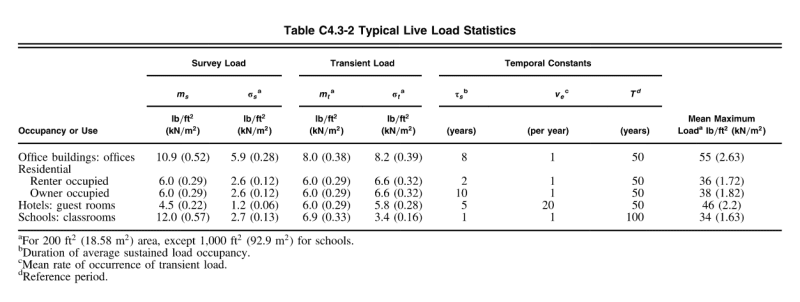I am looking for information on how the live load limits we all see in the IBC were established. Like, how was 40 psf established for residential floors? Was it for occupants of some average weight spread throughout a room at a certain density? I have taken these LL's as a given all these years, but really want to know what assumptions they made to arrive at these numbers. Even the IBC commentary seems to take the values as given, without much explanation about what they mean.
Navigation
Install the app
How to install the app on iOS
Follow along with the video below to see how to install our site as a web app on your home screen.
Note: This feature may not be available in some browsers.
More options
Style variation
-
Congratulations MintJulep on being selected by the Eng-Tips community for having the most helpful posts in the forums last week. Way to Go!
You are using an out of date browser. It may not display this or other websites correctly.
You should upgrade or use an alternative browser.
You should upgrade or use an alternative browser.
How Were Uniform Live Load Values Established in the Code? 4
- Thread starter Envelope3
- Start date
- Status
- Not open for further replies.
-
3
- #2
Here's some light reading for you...
-
1
- #3
ClearCalcs
Structural
phamEng that was a super enlightening read - thank you for sharing that! Good memories from my structural reliability class. Easy to take for granted now but the amount of coordination that would've needed to happen for all specifications to accept load combinations, resistance factors, and reliability levels that got us where we are today with LRFD is quite impressive.
Envelope3, one picture that I always find helps visualize where those values in psf come from is from the AASHTO guide for pedestrian bridges:

-Laurent
Envelope3, one picture that I always find helps visualize where those values in psf come from is from the AASHTO guide for pedestrian bridges:

-Laurent

This is a recent example of why we design for high live loads.
I work in structural design for medium industry, manufacturing. So many of the walkway are maintenance only and it does seem ridiculous to design for 2.5kPa (50psf) especially on a 25m bridge walkway. Though you neve know what will happen in the future.
Even the 5kPa I used to design for flooring in the general plant area seems excessive. Until two years later I'm back in the same place to swap a major (17T) piece of equipment out and the only solution was to skate it across the floor. (The joists and the floor still needing upgrading but the main members were fine being designed for 5kPa.)
Live loads have always felt like overkill to me. Especially given they’re factored up again by 50%.
Dead load have always been where I’ve gotten into trouble. The code gives you this paltry 20% buffer, then the builder goes and pours the podium slab 350mm thick instead of 220mm because it “works better than way”, and then tops it with another 100mm in places…
Dead load have always been where I’ve gotten into trouble. The code gives you this paltry 20% buffer, then the builder goes and pours the podium slab 350mm thick instead of 220mm because it “works better than way”, and then tops it with another 100mm in places…
- Thread starter
- #7
Yeah i'm finding that ASCE7 talks about a Delphi method that was run around 1980 and its results were fed into the 1980 A58 document that was cited above.
It appears in that study, all they did was ping 25 SE's and see what uniform load they'd vote for, and this is how we arrived at 40 psf. It seems dicey but i'm still researching.
It appears in that study, all they did was ping 25 SE's and see what uniform load they'd vote for, and this is how we arrived at 40 psf. It seems dicey but i'm still researching.
It looks like you're reading in the ASCE 7 commentary. They have this nice little table that gives you some statistics. It shows pretty nicely why some of the live load feels excessive...and it's because it is 95% of the time. Another 4% it's reasonable, and then that 1% of the time it's barely adequate.
But who wants to be the one to say it's okay for it's okay for structures to fail 1% of the time? Not this guy.

But who wants to be the one to say it's okay for it's okay for structures to fail 1% of the time? Not this guy.

Baker, in "The Steel Skeleton" had a bit of a discussion on loading... depending on the area under consideration it reduced quickly... I'd scan the page, but my book is packed in the basement.
-----*****-----
So strange to see the singularity approaching while the entire planet is rapidly turning into a hellscape. -John Coates
-Dik
-----*****-----
So strange to see the singularity approaching while the entire planet is rapidly turning into a hellscape. -John Coates
-Dik
Exactly.phamENG said:But who wants to be the one to say it's okay for it's okay for structures to fail 1% of the time? Not this guy.
This is especially true when live loads are often crowds of people and so the 1% or even 0.01% of the chance it might occur is at a time where the damage (injury/loss of life) is at its maximum.
Google balcony collapse and you'll find that it is an all too common occurrence. Just one example were it is normally the 0.01% of the time and lots of people are hurt.
human909, the thing with platform loads in industry is that most of the time it's just one guy. Then something breaks and a couple of guys carry buckets full of tools and equipment up there, or a bunch of random spare parts, or someone decides it's a great place to store something or someone decides to roll equipment across it.
Realistically, though, unless you're doing something odd, or really need to hit long spans, the minimum practical size of channels and steel sections tends to give you way more capacity that you'd reasonably need in most of those situations.
Realistically, though, unless you're doing something odd, or really need to hit long spans, the minimum practical size of channels and steel sections tends to give you way more capacity that you'd reasonably need in most of those situations.
- Thread starter
- #12
I think the root problem is that it's not well understood what 40psf means. I think the general public thinks that you could pack a residence with people (it's not unreasonable to expect that you can use a house living room for a graduation party) and it should be fine, but in actuality it's iffy. When an apartment building is designed, does the PE tell the owner this?
- Status
- Not open for further replies.
Similar threads
- Replies
- 4
- Views
- 820
- Question
- Replies
- 12
- Views
- 1K
- Locked
- Question
- Replies
- 3
- Views
- 4K
- Question
- Replies
- 4
- Views
- 3K
